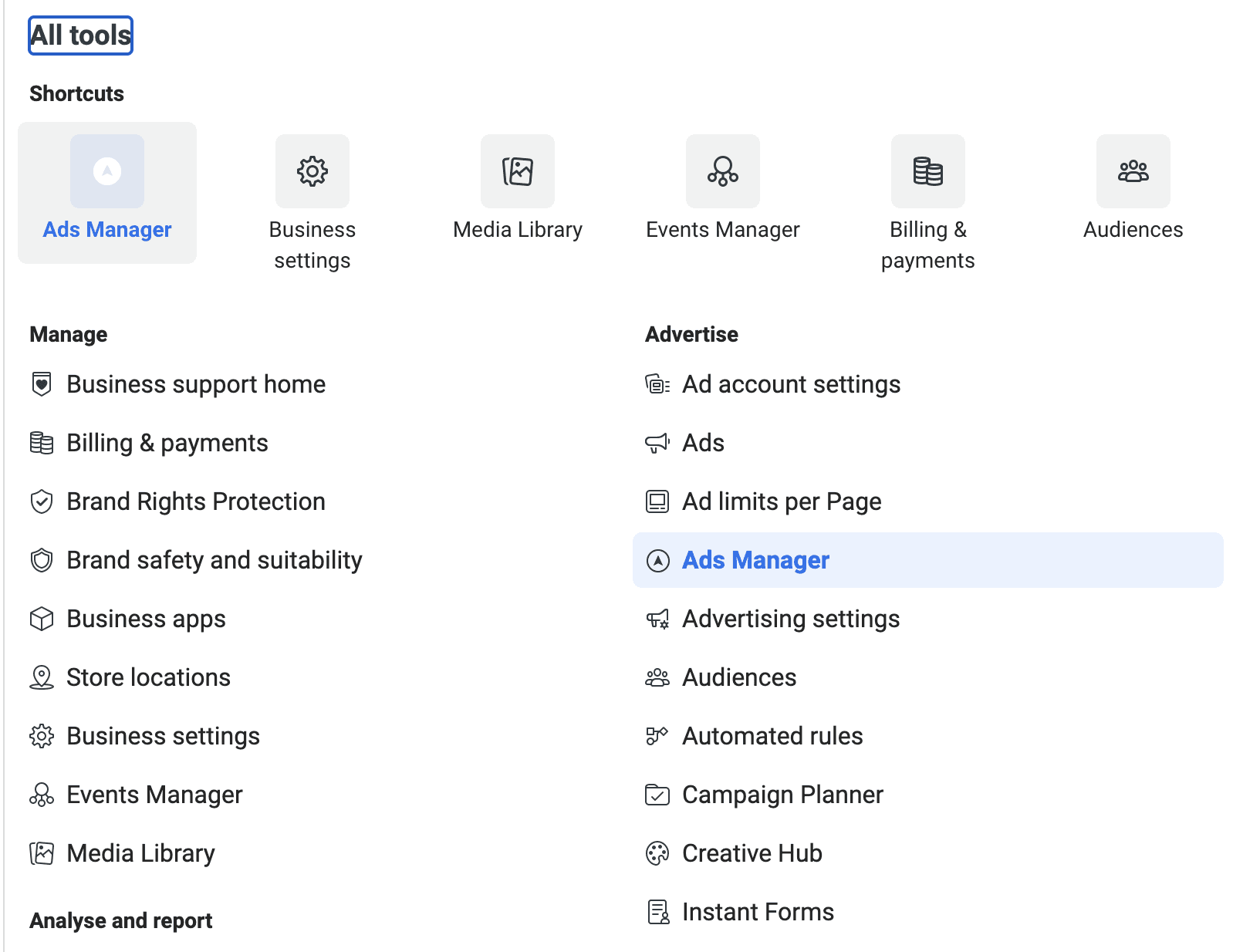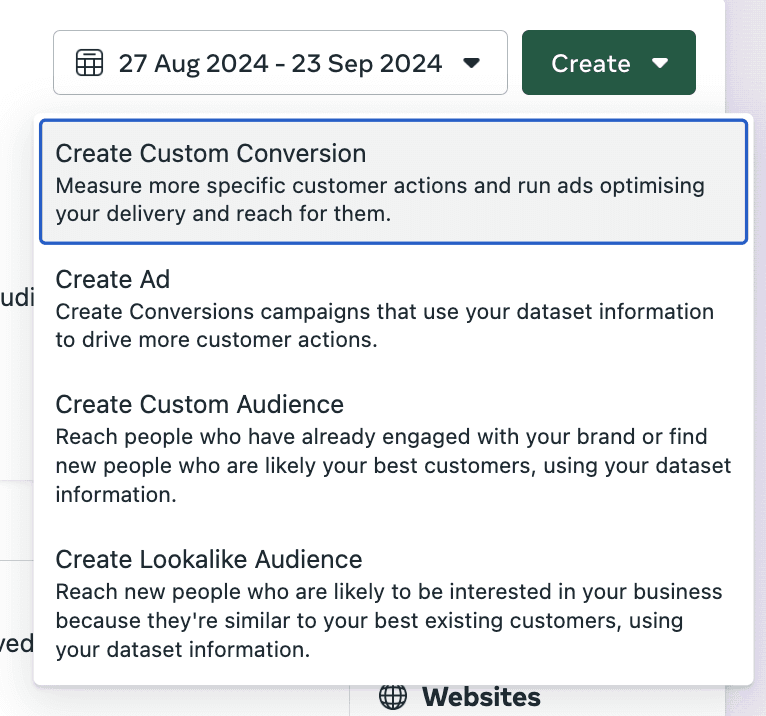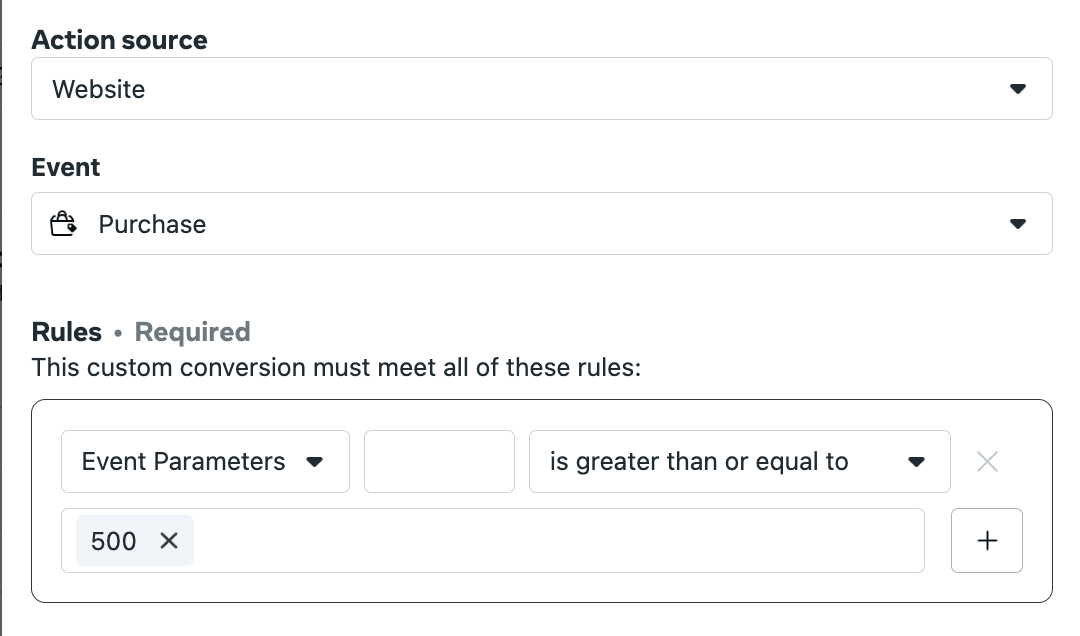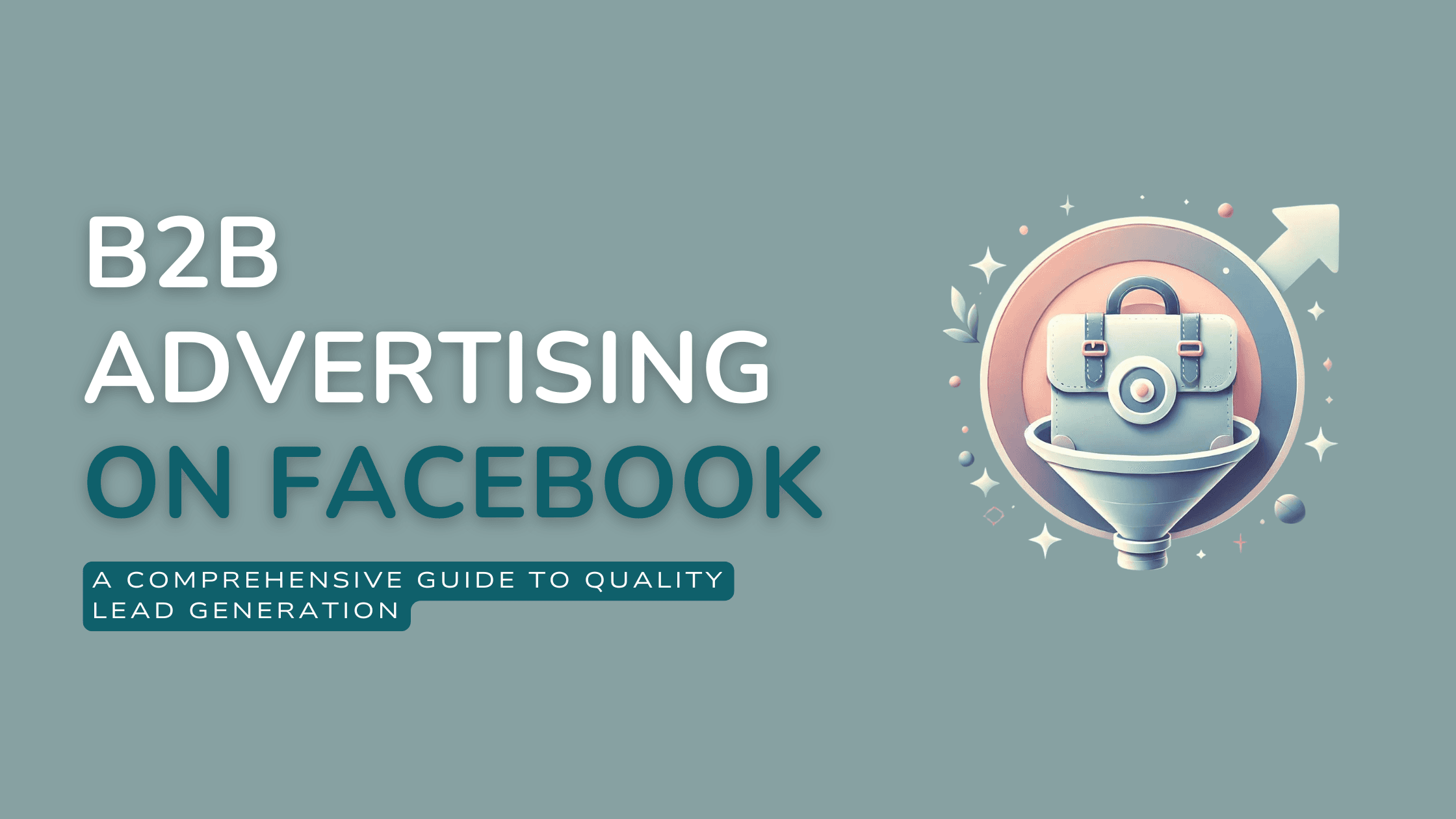B2B Advertising on Facebook: A Comprehensive Guide to Quality Lead Generation
Struggling with B2B advertising on Facebook? Discover advanced strategies to optimize your campaigns for high-quality leads, improve targeting, and boost ROI. Learn how to refine your audience, use custom conversions, and educate Facebook's algorithm to deliver better results for your business.
Are you struggling with B2B advertising on Facebook? You're not alone. Many marketers say:
"We don't run Meta lead gen ads because they don't work for us. The majority of the leads we get are trash."
If this sounds familiar, you're in the right place. We're about to revolutionize your approach to B2B advertising on Facebook, turning those trash leads into great opportunities.
The Common Pitfall in B2B Advertising on Facebook
Let's face it: most B2B advertisers are making a crucial mistake in their Facebook advertising strategy. They're telling Facebook (or Meta, as it's now known) to do this:
Set up a generic lead event
Establish a daily budget
Generate lots of cheap leads
Here's the problem:
Facebook is doing exactly what you're asking. You're getting tons of leads at fantastically low prices. So why isn't it working The issue is simple but profound: in your B2B advertising on Facebook, you're not telling Meta who your ideal customer is. Let's turn it around.
Revolutionizing Your B2B Advertising on Facebook: Quality Over Quantity
To transform your B2B advertising on Facebook, we need to shift focus from lead quantity to lead quality.
Define Your Ideal B2B Customer for Facebook Advertising
Before diving into ad creation, invest time in developing detailed ideal customer profiles. This will help you to tailor your creative for you ICP and not just any lead. You could have multiple ICP profiles, and you can target them at the same time. This process involves:
Industry Analysis
Identify the specific industries that benefit most from your products or services.
Company Size
Define the ideal company size range (e.g., SMBs with 50-250 employees or enterprises with 1000+ employees).
Decision-Maker
Define the job titles and roles of individuals who typically make purchasing decisions for your offerings.
Pain-Point Mapping
List the key challenges and pain points your ideal customers face that your product or service addresses.
Behavioral Traits
Identify common behaviors or characteristics of your best customers (e.g., early adopters of technology, data-driven decision-makers).
Example ICP:
Industry (SaaS companies in the marketing technology sector)
Company Size (100-500 employees)
Decision-Maker (CMO or VP of Marketing)
Pain Points (Difficulty in attribution, inefficient marketing spend, lack of data integration)
Behavioural Traits (Tech-savvy, data-driven, growth-focused)
By doing this exercise you define your audience in more detail. It's very helpful when you start setting up conversion events, lead forms and work on the ad creatives. I would recommend spending quit a bit of time on this step.
Use Custom Conversions in Your B2B Facebook Ads
Instead of relying on generic lead events, create custom conversion events that reflect your ideal customer profiles. By setting up custom conversions and assigning values to different types of leads, you're essentially teaching Facebook what a high-quality lead looks like for your business. This approach transforms Facebook from a simple lead generation tool into a sophisticated partner in finding and engaging your ideal B2B customers. This allows you to send more nuanced signals to Meta's algorithm about what constitutes a valuable lead for your business.
Go to Facebook Ads Manager
This is the main dashboard where you manage your Facebook advertising campaigns. You can access it by going to business.facebook.com and selecting your ad account.

Navigate to Events Manager → Custom Conversions
In Ads Manager, look for Events Manager in the main menu. Once in Events Manager, find the Custom Conversions option. This might be under a submenu depending on your interface version.

Create events that signify high-quality leads
Here's where it gets interesting. You're essentially creating new "events" that represent actions taken by your ideal leads. It's important to note that we might be using the parameters to create those events, so make sure you send the lead form replies as parameters. For B2B advertising, these could include:
Downloading a specific whitepaper (e.g., "Enterprise-Level Solution Guide")
Filling out a contact form with specific criteria met (like company size or industry)
Signing up for a demo of your premium product
To create these:
Click Create Custom Conversion
Define the rules for this conversion. For example, URL contains "/thank-you-enterprise-whitepaper", or, if using parameters: Event = "Lead" AND Parameter "company_size" > 500

Assign values to leads based on quality
This is crucial for optimizing your campaigns. You're telling Facebook which leads are more valuable to you. When creating or editing your custom conversion, you'll see an option to Assign a value to this conversion. Input different monetary values for different quality levels.
For instance:
High-Quality Lead (C-level exec from a large company): $500
Medium-Quality Lead (manager from a mid-size company): $200
Standard Lead (entry-level from a small company): $50

These values don't have to represent actual revenue, they're relative values to help Facebook understand which leads are more important to you.
By setting up these custom conversions and assigning values, you're effectively creating a more nuanced signal for Facebook's algorithm to learn from. Instead of treating all leads equally, the algorithm will now understand that certain types of leads (those that trigger your high-value custom conversions) are more desirable. This will guide Facebook to optimize your ad delivery towards audiences more likely to generate these high-value conversions.
Remember, after setting these up, you'll need to use these custom conversions as the optimization event in your ad sets. This tells Facebook to find more people likely to complete these specific high-value actions, rather than just general leads. This also means that you can bid higher for high-value audiences and much lower for standard leads.
Build Smart Lead Forms for B2B Facebook Advertising
Utilize Facebook's lead gen forms to your advantage by including strategic qualifying questions. This not only helps filter out low-quality leads but also provides valuable data to Meta's algorithm about your ideal customers.
Example qualifying questions:
What is your company's primary industry?
How many employees does your company have?
What is your role in the purchasing decision process?
What is your biggest challenge in (relevant area of your business)?
What is your timeline for implementing a solution?
Pro Tip: Use conditional logic in your forms to create a branching questionnaire. This allows you to gather more detailed information from promising leads while quickly filtering out unqualified prospects.
Educate Facebook's Algorithm on B2B Lead Quality
Remember, Meta's algorithm doesn't inherently understand the difference between a high-quality and low-quality lead for your business. It's crucial to communicate this through the events and data you send back to the platform.
Strategies for clear value communication
Based on the parameters that you get from your standard lead event, create multiple custom conversions to defferentiate between the quality. Later you can use these events to set up campaigns with different conversion goals and different bidding (e. g. you can build 3x-4x for the ICP events, compared to a standard lead if they are more valuable).
Assign different values to each lead type in your custom conversions.
Regularly update your custom audience lists with information about which leads converted into customers, allowing Meta to learn from this data.
This approach to B2B advertising on Facebook offers several significant benefits that will improve your growth efforts. First and foremost, it leads to improved targeting. By feeding high-quality data back to Facebook about your valuable leads and customers, you enable the platform to find similar users more effectively. This means your ads are more likely to reach potential clients who closely match the profile of your ideal B2B customer, increasing the chances of attracting genuinely interested prospects.
Moreover, this strategy results in better ad optimization. Facebook's algorithm uses the detailed information you provide to fine-tune your ad delivery. It prioritizes showing your ads to users who are more likely to take actions that result in high-quality leads, such as requesting a demo or downloading a whitepaper.
Perhaps most importantly, this approach leads to more efficient spending and sets you up for scale. By directing your ad budget towards users who closely resemble your high-value leads and customers, you're likely to see a better return on your advertising investment. By optimising for different custom conversions, you can bid differently for different levels of lead quality. You can focus your budget on reaching the most promising prospects, rather than being spread thin across a less targeted audience and pay more for the leads that matter.
Furthermore, as you consistently feed more data back to Facebook about your successful conversions and high-value customers, the platform's understanding of your ideal B2B customer becomes increasingly refined over time. This ongoing learning process means that your targeting and optimization continue to improve, making your B2B advertising on Facebook more effective and efficient with each campaign.
Remember, the key here is to move beyond treating all leads equally. By differentiating between lead qualities and consistently updating Facebook with this information, you're enabling the platform to become smarter about finding the right B2B prospects for your business.
Optimize Your B2B Facebook Ads for Quality Leads
Now that you've set up custom conversions for different lead qualities, it's time to leverage this information to optimize your B2B Facebook ads. This is where the magic happens – you're going to tell Facebook to focus on your high-quality lead events, effectively steering your ad spend towards the leads that matter most.
First, let's consider how to set up different conversion events for various customer types.
For instance, you might create three custom conversions:
Enterprise_Demo_Request for large companies requesting a product demo
Mid_Market_Whitepaper_Download for medium-sized businesses downloading an in-depth whitepaper
Small_Business_Signup for small businesses signing up via a form
Each of these events represents a different level of lead quality and potential customer value. By setting them up as separate custom conversions, you can create distinct ad sets optimized for each.
Now, here's where it gets interesting: you can adjust your bidding strategy and budget allocation based on the value of each lead type.
For your high-value "Enterprise_Demo_Request" conversion, you might use a higher bid and larger budget, reflecting the greater potential revenue from these leads. You could set a target cost bid strategy with a higher target cost per action, telling Facebook you're willing to pay more for these valuable leads.
For the "Mid_Market_Whitepaper_Download", you might use a moderate bid and budget, while the "Small_Business_Signup" could have a lower bid and smaller budget allocation.
Remember, in B2B advertising, a single high-quality lead can often be worth dozens or even hundreds of lower-quality leads. By optimizing for these high-value events, you're effectively telling Facebook to find more of your ideal customers – those most likely to convert into significant, long-term business relationships.
Advanced Strategies for B2B Advertising on Facebook
Content Personalization: Use dynamic ad creative tailored to specific industries or roles.
Content personalization is a powerful strategy in B2B Facebook advertising that allows you to tailor your ad creative to specific industries or roles. This approach goes beyond basic targeting by dynamically adjusting ad content based on who's viewing it. By leveraging Facebook's advanced tools like Dynamic Creative and Dynamic Ads, you can create a more personalized and engaging ad experience for your potential B2B clients.
You start by providing multiple variations of ad components, including headlines, images, descriptions, and call-to-action buttons. It's a bit like Google Performance Max campaigns. Facebook's sophisticated algorithm then takes these components and mixes and matches them to create personalized ads for each viewer. This means that a CEO in the healthcare industry might see a different version of your ad compared to a marketing manager in the tech sector, even though they're both part of your target audience.
The benefits of this approach in B2B advertising are obvious. Firstly, it dramatically increases the relevance of your ads to individual viewers, making them more likely to engage with your content. This improved relevance often leads to higher engagement rates, better quality leads, and ultimately, a higher return on ad spend. Additionally, content personalization allows you to simultaneously test multiple creative elements, giving you valuable insights into what resonates best with different segments of your B2B audience.
Implementing content personalization in your B2B Facebook advertising strategy does require more upfront work in creating various ad components. However, the payoff in terms of ad performance and audience insights makes it well worth the effort. By showing potential clients that you understand their specific needs and challenges, you're more likely to capture their interest and move them further along the B2B buying journey.
In an increasingly crowded digital advertising space, this level of personalization can give your B2B company a significant competitive edge.
Measuring Success in B2B Facebook Advertising
Track these metrics to measure the effectiveness of your B2B advertising on Facebook. Let's break each one down.
Quality-Adjusted Lead Volume
This metric goes beyond simply counting the number of leads. It weights leads based on their quality or likelihood to convert.
How to calculate:
Assign quality scores to leads based on criteria important to your business (e.g., company size, budget, urgency)
Multiply the number of leads by their respective quality scores
Sum these values for your quality-adjusted lead volume
Example:
10 high-quality leads (score of 3) = 30
20 medium-quality leads (score of 2) = 40
30 low-quality leads (score of 1) = 30
Quality-Adjusted Lead Volume = 100
Why it's important:
It gives you a more accurate picture of lead value than raw lead count.
Cost Per Qualified Lead (CPQL)
This metric measures how much you're spending to acquire leads that meet your qualification criteria.
How to calculate:
Total ad spend / Number of qualified leads
Example:
If you spent $5000 on ads and generated 50 qualified leads, your CPQL would be $100.
Why it's important:
It helps you understand the efficiency of your ad spend in generating valuable leads.
Lead-to-Opportunity Conversion Rate
This measures the percentage of leads that convert into genuine sales opportunities.
How to calculate:
(Number of leads that become sales opportunities / Total number of leads) x 100
Example:
If 20 out of 100 leads become sales opportunities, your conversion rate is 20%.
Why it's important:
It indicates the quality of your leads and the effectiveness of your lead nurturing process.
Customer Acquisition Cost (CAC)
This metric calculates the total cost of acquiring a new customer, including advertising and sales expenses.
How to calculate:
(Total sales and marketing costs) / (Number of new customers acquired)
Example:
If you spent $100,000 on sales and marketing in a month and acquired 10 new customers, your CAC would be $10,000.
Why it's important:
It helps you understand how much you're investing to acquire each customer, which is crucial for profitability analysis.
Lifetime Value to CAC Ratio (LTV/CAC)
This ratio compares the lifetime value of a customer to the cost of acquiring that customer.
How to calculate:
Customer Lifetime Value / Customer Acquisition Cost
Example:
If your average customer's lifetime value is $50,000 and your CAC is $10,000, your LTV:CAC ratio is 5:1.
Why it's important:
It helps you determine if your customer acquisition efforts are profitable in the long run. A higher ratio indicates better long-term value from your marketing efforts.
By tracking these metrics, you can gain a comprehensive understanding of your B2B advertising performance on Facebook. They help you assess not just the quantity of leads, but their quality, the cost-effectiveness of your campaigns, and the long-term value they bring to your business.
Remember, these metrics are most valuable when tracked over time, allowing you to identify trends and the impact of changes in your advertising strategy.
Conclusion
By implementing these advanced strategies, you're not just improving the quality of your leads – you're providing Meta's algorithm with the sophisticated information it needs to find more of your ideal customers. While this approach may result in fewer total leads, the leads you do acquire will be far more likely to convert into valuable, long-term customers.
Remember, in the B2B space, a single high-quality lead can often be worth dozens or even hundreds of low-quality leads. By focusing on quality over quantity in your Facebook advertising strategy, you're setting your business up for:
Higher conversion rates from lead to customer
Increased average deal size
Shorter sales cycles
Improved customer retention rates
Better overall ROAS and CPL
Don't settle for a bunch of unqualified leads that drain your sales team's time and resources. Instead, use the full power of Meta's advanced targeting and optimization strategies to connect with the businesses that truly need your products or services. With this strategic, quality-focused approach, B2B advertising on Facebook can transform from a source of frustration into a powerful engine driving your company's sustainable growth and market leadership. If you would like to work with on scaling your B2B SaaS business, book a call here.
FAQs
Q: How can B2B advertisers improve their Facebook ad performance?
A: B2B advertisers can improve performance by defining detailed ideal customer profiles, using custom conversions, building smart lead forms, and educating Facebook's algorithm on lead quality.
Q: What are custom conversions in Facebook ads?
A: Custom conversions are specific events you create that represent high-value actions taken by your ideal leads, such as downloading a whitepaper or requesting a demo. They help Facebook optimize for quality leads.
Q: How can B2B advertisers use lead forms effectively on Facebook?
A: Use strategic qualifying questions in lead forms to filter out low-quality leads and provide valuable data to Facebook's algorithm about your ideal customers.
Q: What's the benefit of assigning different values to leads?
A: Assigning different values to leads helps Facebook understand which leads are more valuable to your business, allowing for better ad optimization and more efficient spending.
Q: How does optimizing for high-quality leads affect overall results?
A: Focusing on high-quality leads may result in fewer total leads but can lead to higher conversion rates, increased deal sizes, shorter sales cycles, and better overall return on ad spend.


